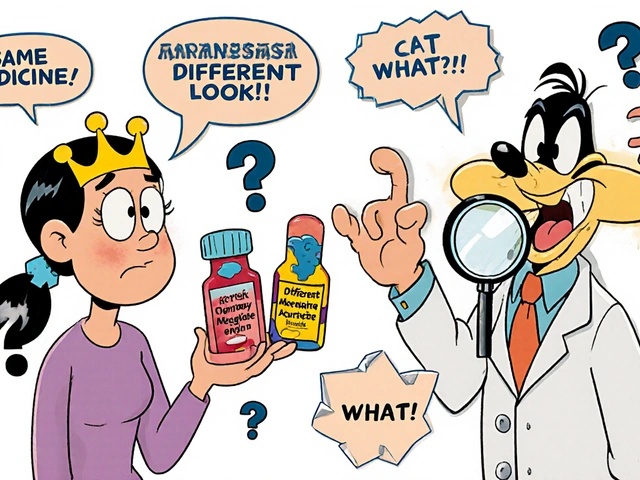Imagine being stranded at sea with nothing green in sight, knowing your teeth could start falling out from a disease nobody understood yet. That’s exactly what happened to sailors before they stumbled onto the not-so-glamorous-sounding scurvy grass. The plant’s name comes right out of medical history, but it’s having a moment in the spotlight today for totally different reasons. Scurvy grass isn’t just a relic; it’s suddenly hot in the world of natural health and nutrition. But what’s the story behind this old-fashioned weed? And why are science geeks, herbal traditionalists, and wellness influencers all raving about it? The truth is, scurvy grass ticks boxes no other leafy green quite can, thanks to its potent package of vitamins and its quirky chemical punch. There’s way more here than meets the taste buds (spoiler: they tingle!)—so let’s get to the root of what makes this tongue-zinging plant a staple for the truly health-savvy.
The Science Behind Scurvy Grass: Nutritional Powerhouse From the Coast
Scurvy grass (Cochlearia officinalis), a hardy little plant from the cabbage family, made a name for itself during the days of wooden ships. Back then, scurvy—a disease caused by vitamin C deficiency—was an unavoidable nightmare for sailors. As it turns out, this plant packs more vitamin C per 100 grams than classic citrus fruits. How much more? According to a chemical analysis published in the Journal of Ethnopharmacology, fresh scurvy grass leaves can contain up to 200 mg of vitamin C per 100 grams. For comparison, the same serving of orange gives you about 53 mg. That’s nearly four times as much—no wonder sailors swore by the stuff.
But vitamin C isn’t the only thing going for scurvy grass. Its leaves also come loaded with glucosinolates, those sharp-tasting compounds you taste in mustard, horseradish, and wasabi. These are highly researched for their potential in supporting immune function and even inhibiting certain enzymes involved in inflammation. Scurvy grass also contains obvious must-haves like fiber, iron, calcium, potassium, and magnesium, all wrapped up in a bright green leaf that likes to grow on salty, windswept shores. Nutrition nerds get excited, because you can see all this at a glance:
| Nutrient | Scurvy Grass (per 100g) | Oranges (per 100g) | Kale (per 100g) |
|---|---|---|---|
| Vitamin C | 200 mg | 53 mg | 120 mg |
| Iron | 1.9 mg | 0.1 mg | 1.5 mg |
| Calcium | 85 mg | 40 mg | 150 mg |
| Potassium | 450 mg | 181 mg | 491 mg |
| Fiber | 3.4 g | 2.4 g | 2.0 g |
If you’re wondering what all these numbers mean for your body, check this out: Vitamin C keeps your immune system strong, but it also helps your skin, helps your body absorb iron, and even supports healthy gums and joints. Meanwhile, glucosinolates provide a defense layer against oxidative stress, which means your cells get extra protection from everyday wear and tear. Researchers from Norway even found that people who consistently ate coastal plants like scurvy grass showed stronger antioxidant activity in blood tests than those who stuck strictly to common grocery veggies. It turns out the plant’s seaside habitat forces it to make more protective compounds, so you get the benefit when you eat it.
But don’t let the technical talk put you off—this isn’t a plant reserved only for botanists and nutritionists. The real headline is this: scurvy grass offers you a fast-track hack to the benefits of a big salad, all in a peppery bite you can use almost any way, from topping eggs to blending into pestos. And with the current movement toward wild, foraged foods, this plant is finally getting the central spot it deserves on plates, as both a supplement in capsules and in fresh, whole form.

Health Benefits: Real-World Impact Beyond Sailors and Explorers
Everyone talks about vitamin C for immunity, but the way scurvy grass delivers it is different. The absorption rate from fresh greens tends to be higher than in pills, especially because scurvy grass combines vitamin C with fiber and natural bioflavonoids. These extras help shuttle vitamin C exactly where your body wants it. One particularly cool thing: British dieticians researching coastal foragers in Scotland noticed that folks who added scurvy grass to their springtime diets suffered less from common colds than their city cousins. It wasn’t just theory—their data showed a shorter duration and milder symptoms each season.
What about energy? Vitamin C isn’t a stimulant like coffee, but it fights fatigue in quieter ways. It helps your body make carnitine, a molecule your cells need to turn fat into fuel. People with even a mild deficiency often feel tired for no clear reason, and scurvy grass delivers a fix without needing a pharmacy. There are even small, promising studies hinting that plants like scurvy grass can blunt the nausea that sometimes follows intense exercise or travel—likely thanks to its tangy, lightly spicy phytochemicals. Don’t expect a magic cure, but it’s one of those “can’t hurt, might help” touches for endurance sports or tough morning commutes.
If you deal with inflammation—be it allergies, acne, or sore joints—there’s also something to watch. Scurvy grass’s glucosinolates trigger a mild heat response in the mouth and stomach. This sometimes freaks out first-time eaters (think spicy arugula, but more intense), but it signals your immune system to kick into high gear. One lab study at the University of Copenhagen found that extracts from scurvy grass could calm down certain inflammatory markers in test tubes and reduce skin irritation in humans—though they all agreed that chewing the leaves, not just swallowing a pill, gave the best effect. The plant’s unique texture also helps scrape away bacteria if you give it a good chew, so you might even notice fresher breath after eating it regularly (no need for mouthwash).
Let’s not leave out the mental boost. Believe it or not, vitamin C is crucial for your brain as well — it helps your body make neurotransmitters, those little chemicals responsible for mood and focus. Some small-scale research has even linked higher vitamin C intake to improved memory retention in older adults and better test performance in teenagers. Scurvy grass fits right into the snack routine for students, office warriors, or anyone battling the afternoon mental crash.
Another surprising advantage: some foragers claim that scurvy grass helps with PMS and mild menstrual discomfort, likely because its minerals (especially magnesium and calcium) help relax muscle contractions. While the data on this is mostly anecdotal, magnesium is a proven aid for cramps, and scurvy grass can deliver a gentle, natural dose in every handful.
Here’s a rapid-fire cheat sheet of where scurvy grass shines as a supplement:
- Supports strong immune defenses (especially in cold/flu season)
- Relieves minor fatigue and helps natural energy cycles
- Protects mouth health and freshens breath on the go
- Might ease minor joint and muscle soreness
- Lends quick antioxidant support — think of it as a daily shield
- Boosts focus and mood in your brain
- Eases mild cramps and muscle tension

Easy Ways to Add Scurvy Grass to Your Daily Routine
If you’re not ready to go foraging on a stormy beach or dig up the garden, don’t give up. Scurvy grass supplements are popping up in health food stores and online shops, sometimes labeled as “Cochlearia officinalis extract” or simply “Scurvy Grass capsules.” Capsules can be handy if you hate spicy flavors, but you lose out on the mouth-tingling nutrients that fresh leaves give. If you spot it fresh (often at farmers’ markets or foraging groups in early spring), try adding the leaves to salads the same way you’d use arugula or watercress.
The taste? Prepare for a blast: it’s peppery, zesty, and sharp, kind of like horseradish with a citrus twist. Most people love it chopped into cream cheese, Greek yogurt dips, or egg salad for a bit of bite. Some fans swear by blending it into a green smoothie — mix a handful with pineapple, banana, and coconut water to mellow out the heat. To tone down the spiciness, blanch the leaves quickly in boiling water: this makes the flavor much milder and also softens the texture for stir-fries or pasta sauces.
If you’re in the DIY camp, here are some foolproof tips to maximize the benefits and make scurvy grass your secret kitchen weapon:
- Try it raw in mixed salads: use it in place of, or alongside, scurvy grass for a bigger vitamin C kick.
- Chop and top: sprinkle over steamed veggies, oven-roasted potatoes, or scrambled eggs for a bright finish.
- Whip up an herby dip: blend fresh scurvy grass with olive oil, lemon, garlic, and sunflower seeds.
- Infuse in water: add a few fresh leaves to a pitcher of cold water with sliced cucumber for a zingy detox drink.
- Blend into pesto: replace some of the basil or arugula in your favorite pesto recipe for a unique, spicy edge.
Of course, if you’re pregnant, on medication, or dealing with chronic kidney concerns, chat with your healthcare provider before adding a new supplement or herb—especially one as punchy and mineral-rich as this. The vitamin C levels can interact with certain medications, and high doses of glucosinolates may not agree with everyone. Start small: a few leaves every few days to test your tolerance before you go wild.
As wild foods and foraged greens go, scurvy grass might be the most underestimated supplement you’ll find. It packs the nutrition of a full farmstand into a handful of leaves, gives you a legend-worthy backstory, and delivers a hit of flavor that’s anything but boring. Whether you want to supercharge your daily greens or just impress someone with your health trivia, scurvy grass is about as far from “just another green” as it gets. Give it a try and see why generations—ancient to modern—won’t let this super plant get lost in the weeds.





Zuber Zuberkhan
July 18, 2025 AT 14:24This is a fascinating look into scurvy grass! It’s incredible how nature has provided amazing solutions for our health throughout history, right? The article really highlights how this superfood goes beyond just old-fashioned remedies and plays a vital role in nutrition today.
I’m especially intrigued by its vitamin C content, which back in the day literally saved sailors’ lives at sea. It makes sense to consider incorporating it more into our modern diets, maybe even alongside other supplements we rely on. The practical tips section sounds like it could help a lot of people actually try this stuff instead of just hearing about it.
Does anyone know if scurvy grass is easy to grow at home? I'd love natural options to boost wellness further. Also, how does it compare to more common superfoods or herbal supplements out there?
Jessica Forsen
July 21, 2025 AT 20:24Oh wow, a plant rich in vitamin C that’s not just your regular orange or kiwi? Honestly, this sounds like one of those things that people will jump on overhyped about for a minute and then forget it. But hey, I love that it has actual historical significance and some science backing it.
Anyone else feel like these old-school herbal remedies suddenly becoming 'superfoods' is just a recycled marketing tactic? Just saying, before we all go running to buy scurvy grass supplements, maybe do a little homework first.
Still, I’m mildly intrigued and open to seeing what the taste and practical use is like. Thanks for the detailed tips!
Deidra Moran
July 23, 2025 AT 11:04Look, if you think scurvy grass is some magical elixir, you need to think twice. Most people don't realize the shady history of forgotten remedies being pushed under the guise of 'superfoods' just to make a quick buck on the wellness train.
I’m pretty skeptical about all these claims until the evidence is rock solid. Vitamin C content doesn't automatically mean it will heal or energize you magically, especially if the supplements are processed or marketed by sketchy companies trying to cash in on trends.
Plus, how many of you have looked into whether these compounds interact with medications or existing conditions? People need to be cautious and not blindly jump onto bandwagons just because vitamins are involved.
Andy McCullough
July 26, 2025 AT 05:20From a biochemical perspective, scurvy grass is indeed an interesting plant due to its ascorbic acid profile and other bioactive components such as glucosinolates. These compounds contribute to various physiological benefits, including antioxidant activity and potential inflammation modulation.
The article’s exploration of the mechanistic pathways by which these nutrients can impact systemic health is commendable. However, quantifying the bioavailability and therapeutic dosage remains essential before fully endorsing it as a superfood supplement.
I'd be curious to know more about the comparative efficacy versus established vitamin C sources and whether there are peer-reviewed clinical trials supporting these claims. Any insights on this?
NIck Brown
July 28, 2025 AT 12:53Honestly, while the history is cool, I feel like people get way too excited about these “ancient remedies” as if they’re superior just because they’re old. Modern nutrition science has advanced far beyond what sailor survival diets were based on.
For all we know, they were just lucky to find any vitamin C source at all. Now, with fortified foods and supplements, chasing after scurvy grass sounds more like a fad than a genuine necessity.
But hey, anyone else care to share if they’ve tried it and actually noticed difference? Sometimes experience trumps theory.
Deepak Bhatia
July 30, 2025 AT 20:26I appreciate the optimistic viewpoint here. It’s refreshing to see natural options highlighted for health benefits, especially those with historical context. Sometimes we overlook what’s right in front of us, and nature has always been an excellent source of healing.
In my experience, incorporating diverse plants and herbs into diets can improve energy and overall wellbeing. Though it’s essential to balance with modern medicine, plants like scurvy grass remind us to respect traditional wisdom and explore holistic health.
Would love to hear how others incorporate this into their routines or any recipes they enjoy!
Brooke Bevins
August 2, 2025 AT 04:00I’m so here for this! 🌿 I’ve been looking for new ways to boost my vitamin C through something natural, not just pills. It’s amazing how scurvy grass packs such nutritional punch and has an authentic story behind it.
The idea of using scurvy grass in everyday meals or as a supplement excites me — has anyone tried adding it to smoothies or teas? Would love some suggestions. It might be a game changer for those of us tired of the same old sources.
Also, the article’s mention of its unique compounds makes me wonder if it has benefits beyond just vitamin C. Can anyone confirm or provide personal insights?
Samantha Gavrin
August 5, 2025 AT 15:20People should really dig deeper on this one. There’s always something they’re not telling us about these so-called superfoods. Like, why was scurvy grass pushed aside for so long? Could it be related to pharmaceutical interests controlling what we consume and promoting their synthetic vitamins instead?
I’m suspicious that breaking this into mainstream nutrition may be a controlled release of information, giving people just enough to use but not enough to disrupt the big industry profits. Just a thought.
Nevertheless, it’s crucial to remain cautious and search for unbiased sources before recommending scurvy grass as a miracle supplement.
Vandita Shukla
August 10, 2025 AT 06:26Haha, this discussion is wild but interesting. From what I understand, scurvy grass thrives wild in certain regions, and you can actually forage it yourself if you know where to look! Not exactly a mainstream herb but definitely not super rare.
Also, careful with claims about its miraculous powers — it’s one more plant in a vast world of herbal remedies with specific nutrients, not a cure-all.
I do appreciate when people share practical tips for usage and recipes because that’s how these old remedies stay relevant. Mixing in some skepticism and knowledge is key to enjoying its benefits responsibly.
Mr. Zadé Moore
August 12, 2025 AT 14:00The rhetoric around scurvy grass is, frankly, dripping with hyperbolic essentialism. People often invoke scientific jargon vaguely to inflate these narratives about antique plants being indispensable today.
While the phytochemical constituents are noteworthy, it’s crucial to critique the epistemological framework here. We must differentiate between anecdotal survivability and empirically validated health efficacy.
This doesn’t diminish its potential use, but the sensationalism must stop to allow critical, measured integration into modern dietary guidelines.
Tara Newen
August 16, 2025 AT 01:20Honestly, I’m all for prioritizing local, natural remedies but let’s get real: not everything old is best. American health trends often get hijacked by repackaged foreign concepts until they seem trendy enough.
Scurvy grass might be beneficial, but you better not expect it to replace balanced nutrition or proper healthcare. The national obsession with 'superfoods' sometimes feels like a distraction from systemic diet issues.
Would love to see more rigorous studies before calling it a must-have supplement.